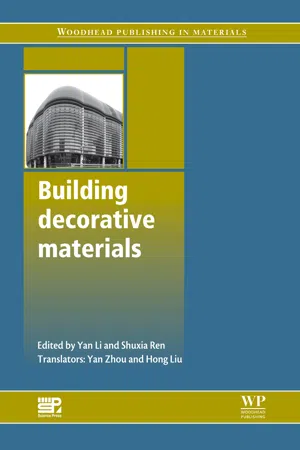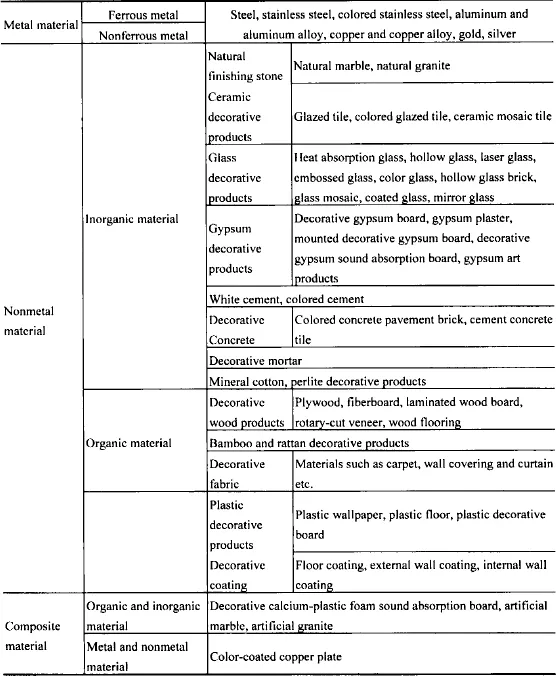
- 420 pages
- English
- ePUB (mobile friendly)
- Available on iOS & Android
Building Decorative Materials
About this book
Buildings should not only be functional but aesthetically pleasing. This requires the use of decorative materials both on the exterior and inside a building. Building decorative materials reviews the range of materials available and their potential applications.The book begins by considering the main types of decorative material and the physical, mechanical and other properties they require. It then discusses types and potential uses of decorative stone materials such as marble, granite, slate or gypsum. It then goes on to discuss the ways cement and concrete can be used for decorative effect, before considering the role of ceramics in such areas as tiling. The following chapters review decorative glass for windows or facades, metals and wood before assessing polymer materials such as plastics and textiles. The final group of chapters discuss coatings, including waterproofing materials, multi-functional materials used for such purposes as soundproofing and thermal insulation, and the use of more sustainable decorative materials.Building decorative materials is a useful reference for architects, civil engineers and those studying civil or structural engineering.- Reviews the full range of materials available for both the exterior and interior of buildings and their potential applications beyond conventional uses- Considers the main types of decorative material and the physical, mechanical and other properties they require as the role of sustainable materials- Discusses types and potential uses of decorative stone materials such as marble, granite, slate or gypsum and explores how cement and concrete can be used for decorative effect
Frequently asked questions
- Essential is ideal for learners and professionals who enjoy exploring a wide range of subjects. Access the Essential Library with 800,000+ trusted titles and best-sellers across business, personal growth, and the humanities. Includes unlimited reading time and Standard Read Aloud voice.
- Complete: Perfect for advanced learners and researchers needing full, unrestricted access. Unlock 1.4M+ books across hundreds of subjects, including academic and specialized titles. The Complete Plan also includes advanced features like Premium Read Aloud and Research Assistant.
Please note we cannot support devices running on iOS 13 and Android 7 or earlier. Learn more about using the app.
Information
Introduction
1.1 Status and Development of Building Decorative Materials
1.2 Types of Building Decorative Materials
| Type | Application site | Commonly-used decorative material |
| External wall decorative material | Decorative material applied to all external parts of a building, including external walls, terraces and awnings etc. | Natural granite, ceramic decorative products, glass products, external wall coating, metal products, decorative concrete, decorative mortar |
| Internal wall decorative material | Decorative material applied to internal structures, including internal wall surface, dados, plinths, partition walls, flower shelves etc. | Wallpaper, wall cloth, internal wall coating, fabric ornaments, plastic facing decorative board, marble, artificial stone, internal wall glazed tile, artificial board/sheet, glass products, thermal insulation and sound absorption decorative board |
| Floor decorative material | Decorative material applied to such structures as ground surface, floor surface and stairs etc. | Carpet, floor coating, natural stone, artificial stone, ceramic floor tile, wood floor, plastic floor |
| Ceiling decorative material | Decorative material applied indoors and for ceiling decoration | Gypsum board, decorative mineral wool sound absorption board, decorative perlite sound absorption board, glass wool, decorative sound absorption board, decorative calcium-plastic foam absorption board, decorative polystyrene foam plastic sound absorption board, fiber board, coating |

1.3 Brief Introduction of Technological Standards of Building Decorative Materials
1 Commonly-used Standards in China
2 World Standard and Regional Standard
1.4 Functions and Selection of Building Decorative Materials
1 Functions of Building Decorative Material
Table of contents
- Cover image
- Title page
- Table of Contents
- Copyright
- Preface
- Chapter 1: Introduction
- Chapter 2: Basic Properties of Building Decorative Materials
- Chapter 3: Building Decorative Stone
- Chapter 4: Gypsum Decorative Materials
- Chapter 5: Building Decorative Cement
- Chapter 6: Building Decorative Concrete and Mortar
- Chapter 7: Building Decorative Ceramic
- Chapter 8: Building Decorative Glass
- Chapter 9: Metal Decorative Materials
- Chapter 10: Decorative Wood
- Chapter 11: Decorative Plastics
- Chapter 12: Building Decorative Fiber Fabric and its Products
- Chapter 13: Architectural Coatings
- Chapter 14: Adhesives
- Chapter 15: Waterproof Materials
- Chapter 16: Acoustic and Thermal Insulating Materials
- Chapter 17: New Energy-saving and Environmental Protective Building Materials
- References
- Index